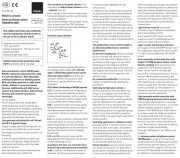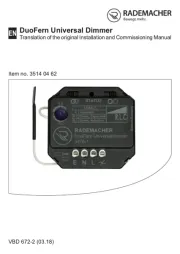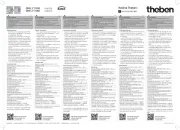
Universal dimmer switch, 300 W power
MOSFET. Automatic lamp detection. Only
0.7 watt standby loss. With adjustable
minimum brightness or dimming speed.
With switching operation for light alarm
clocks, children‘s rooms and snooze
function. Additionally with light scene
control. Encrypted wireless, bidirectional
wireless and repeater function are
45 mm long, 45 mm wide, 33 mm deep.
Universal dimmer switch for lamps up to
300 W, dependent on ventilation conditions.
Dimmable energy saving lamps ESL and
dimmable 230 V-LED lamps, additionally
dependent on the lamps electronics.
Zero passage switching with soft ON and
soft OFF to protect lamps.
Supply voltage, switching voltage and con-
trol voltage local 230 V. No minimum load.
The brightness level is stored on switch-off
In case of a power failure the switch posi-
tion and the brightness stage are stored
and may be switched on when the power
Automatic electronic overload protection
and overtemperature switch-off.
Temperature at mounting location:
Storage temperature: -25°C up to +70°C.
annual average value <75%.
Only skilled electricians may install this
electrical equipment otherwise there is
the risk of re or electric shock!
valid for devices from production week
46/17 (see bottom side of housing)
You can teach in encrypted sensors. You
can switch on bidirectional wireless and/or
Every change in state and incoming central
command telegrams are then conrmed by
This wireless telegram can be taught-in into
other actuators and the GFVS-Software.
The current dimming value is also displayed
in % in the GFVS-Software.
The minimum brightness (fully dimmed) or
the dimming speed is adjustable with the
/dimming speed rotary switch.
The lower rotary switch determines the
operation, whether the automatic lamp
detection or special comfort positions
AUTO allows the dimming of all light species.
EC1 is a comfort position for energy saving
lamps which must be switched on with in-
creased power dependent on the construc-
tion, so they will also switch on again safely
in cold condition when dimmed down.
EC2 is a comfort position for energy saving
lamps which will not be switched on again
when dimmed down dependent on the
construction. Memory is switched off in this
LC1 is a comfort position for dimmable 230 V
LED lamps which are not being dimmed
down enough when set to AUTO (trailing
phase angle) dependent on the construction
and must therefore be forced to leading
LC2 and LC3 are comfort positions for
dimmable 230 V LED lamps like LC1, but with
different dimming curves.
In positions EC1, EC2, LC1, LC2 and LC3 no
inductive (wound) transformers should be
used. In addition, the maximum number of
dimmable LED lamps can be lower than in
the AUTO position dependent on the
In addition to the wireless control input via
an internal antenna, this universal dimmer
switch can also be controlled locally by a
conventional 230 V control switch if tted
previously. Either separate local control
inputs for dim brighter and dim darker as a
direction switch, or these two inputs can be
bridged and controlled with a single switch
as a universal switch. The dimming direc-
tion can then be changed by interrupting
the control. Short control commands switch
The pushbuttons can be either taught-in
as direction pushbuttons or universal
As direction pushbutton 'switch on and dim
up' is on one side and 'switch off and dim
down' on the other side. A double-click on
the switch on side triggers the automatic
dimming up to full brightness with dim
speed time. A double-click on the switch off
side triggers the snooze function. The chil-
dren’s room function is triggered on the
As a universal pushbutton the direction
change is made by briey releasing the
Switching for light alarm clocks: A
wireless signal of a time clock which was
taught-in accordingly starts the wake up
function by switching on the light at the
lowest brightness level and dims up slowly
until the maximum level is reached.
Dependent on the set dim speed the wake
up time is between 30 and 60 minutes.
The dimming process is stopped by tapping
briey, e.g. on the hand-held transmitter.
At setting ESL is no switching for light alarm
Switching operation for children’s rooms
(universal switch or direction switch on the
switch-on side): If the light is switched on
by holding down the pushbutton, it starts at
the lowest brightness level after approx.
1 second and dims up slowly as long as the
pushbutton is held down without modifying
the last stored brightness level.
Snooze function (universal switch or direc-
tion switch on the switch-off side): With a
double impulse the lighting is dimmed down
from the current dimming position to the
minimum brightness level and switched off.
The current dimming position as well as the
adjustable minimum brightness level deter-
mine the dimming time (max. = 60 minutes)
which can be reduced as required. It can be
switched off at any time by short-time
control commands during the lighting is
Light scenes on the PC are set and
retrieved using the Wireless Visualisation
and Control Software GFVS.
One or several FUD71 devices must be
taught in on the PC as dimming switches
with percentage brightness values.
Lights scenes with wireless switches
are taught in on the FUD61NPN device. Up to
four brightness values which can be taught-
in in light scene pushbuttons with double
Semi-automatic motion detection with
taught-in FB65B wireless motion sensor
(factory setting): After switching on via
pushbutton, the 5 minutes delay time
starts, within this time the delay will
restart after each detected motion. 5 minu-
tes after the last detected motion it will
switch off. If a motion is detected 5 minutes
after switching off, it will automatically
switch on again. After this time only a push-
button can switch on. The pushbutton is
allowed to switch off at any time, then the
motions are no more evaluated.
Fully automatic motion detection with
FB65B taught-in wireless motion sensor:
If the actuator should switch on automati-
cally when motion is detected, e. g. in rooms
without daylight, replug the jumper to
'active' on the FB65B device. When motion
is no longer detected, thedevice switches
off automatically after the 5 minutes re-
lease delay time expires. Press the push-
button at any time to switch the device on
or off. When motion is detected, the device
switches on again automatically.
Either an FBH (Master) or an FHD60 can be
If a wireless motion-brightness sensor
FBH (Master) is taught in, the switching
threshold at which the lighting with memory
value switches on (from approx. 30 lux in
the position AUTO to approx. 300 lux in the
position EC2) depending on the brightness
(in addition to the motion) is determined












